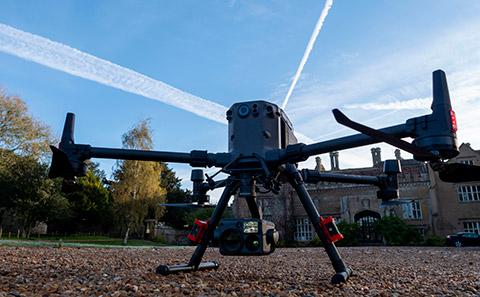
Engineers from the University of Southampton, and conservationists at Marwell Wildlife have successfully trialed the use of drone technology, as a new approach to assisting conservation efforts, writes the University of Southampton in a press release.
The collaboration between the IRIS Centre of Excellence, SotonUAV, Marwell Wildlife and the School of Biological Sciences involved several flight trials at the zoo to test how effective drones carrying specialist cameras and noise sensors could be in identifying and monitoring animals from the air.
The teams conducted the flights in October and November, performing several flights above the zoo’s Wild Explorer’s paddock, which holds herds of critically endangered Grevy’s zebras, scimitar-horned oryx and white rhinos.
The goal is to employ these technologies in remote areas where threatened animal populations are more difficult to monitor.
Your weekly innovation overviewEvery sunday the best articles of the week in your inbox.

Dr Mark Pickering, Impact Acceleration Manager at the IRIS Centre of Excellence, said: “These trials here at Marwell allowed us to gather a great deal of data which we can now work with to look into things like image processing algorithms and machine learning.”
Visual and thermal cameras were mounted to the platforms, as well as AudioMoth acoustic sensors to monitor the noise levels of the drones and record animal sounds.
The drones were operated by SotonUAV, an uncrewed aerial vehicles (UAV) team at the University of Southampton.
Dr Mario Ferraro, Senior Enterprise Fellow and a founder of the SotonUAV group, said: “In these trials we’ve been using the multi-rotor platform to carry the sensor where we needed it.
“When we work in a field trial environment, distances are going to be much larger and we will have to rely on a different kind of platform, most likely a fixed-wing drone.”
Results from the trials show the animals were predominantly unaware of the drones, which were flown at varying heights for short periods of time.
Head of Conservation Biology at Marwell Wildlife, Dr Philip Riordan said: “The trials we have carried out at Marwell have been hugely informative.
“The greatest surprise is the clarity that we’re able to get from these devices, which are hovering above animals in the air, and the resolution and definition that we can see.”
The flights were completed in preparation for overseas field trials, which will look at assisting the conservation effort of endangered animals.
Dr Riordan added: “Technologies, such as the use of UAVs for getting much finer detail monitoring for species such as Snow Leopard and the prey that they rely upon, are very valuable and worth exploring further.”
Mario added: “I think these trials here have proven that tools, such as an aerial robot with the right sensors, are going to be very useful for people working in conservation.”
The project has allowed the teams at IRIS CoE and SotonUAV to gain insight into how their technologies can be used to find solutions to real world problems. This is the first of a number of planned applications of the IRIS CoE’s new EPSRC funded Matrice 300 UAV. The team is also recruiting for a PhD student to work on the project.
Mark said: “By bringing the expertise together across the different departments, we’re able to bring novel technologies to push forward conservation aims.”
Also interesting: KNRM tests use of drones in rescue operations